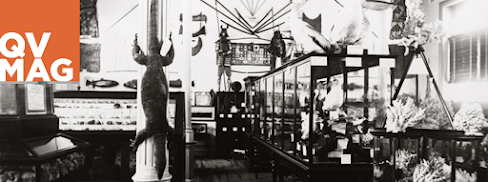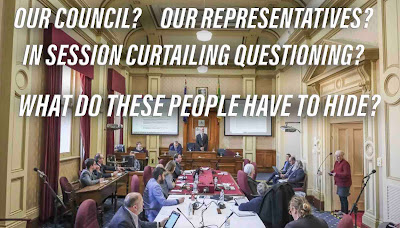 |
| Dr Kim Lehman |
 As with the arts and cultural sectors more widely, the museum sector has been severely affected by the COVID-19 pandemic. [Is the implication here that collectively 'the museum sector' is some kind of 'industry' some thing like 'the arts industry'? If so it is a proposition that is deeply flawed.]
As with the arts and cultural sectors more widely, the museum sector has been severely affected by the COVID-19 pandemic. [Is the implication here that collectively 'the museum sector' is some kind of 'industry' some thing like 'the arts industry'? If so it is a proposition that is deeply flawed.]
Despite the relative success of virtual and digital strategies to engage cultural consumers while museums were closed to the public, a return to sustainable levels of physical visitation to museums is vital as we move towards a post-pandemic world. [The proposition embedded in this paragraph that 'culture is consumed' is highly contestable. Culture is all that we do that makes us –as individuals, as family/tribe, as a group, as a society – who we are. We do it, we do NOT "consume it".]
The recently announced Futures Plan for the Queen Victoria Museum and Art Gallery cannot have come at a more opportune time. [True, except that there is NO PLAN in evidence that has been published that articulates A PURPOSE, A SET OF OBJECTIVES, RATIONALES & STRATEGIES. So, is it the actually the case that 'the plan' is to have a plan? ]
The plan has been described as ambitious, but without radical changes to funding models and governance structures, QVMAG could wither on the proverbial vine. [Excuse us! Without a clearly and unambiguously articulated 'plan' how can it judged "ambitious" ? This renders the proposition outrageously audacious rather than anything like "ambitious".]
However, there are a range of factors at play in this new consumer environment for cultural organisations such as museums, and a range of possible responses. [Excuse us again! The premise here is ill founded in that it is set in 'industrial cum consumerist' paradigm when 'cultural institutions such a museums' should operate outside that realm, albeit engaged with it in various ways. ]
As consumers of culture, museum visitors respond to marketing cues in ways different to consumers of other goods and services. [Excuse us 'cultural producers' are not seeking customers they are seeking to participate in and express their cultural realities within their communities and cultural entities. Yes, they need an income as do a whole range of service providers who have patients and clients who rely upon, depend upon what they have to offer. ]
Sometimes that is not understood by all. [Well yes and because the assumptions it is founded upon just does not fit the circumstance.]
One area that can confuse the museum sector is 'motivation', which sits in the field of consumer behaviour and refers to how and why consumers engage in the consumption process. In this context, it is clear that museums need to better understand what motivates their visitors to attend if they are to recover going forwards. [Again, because the assumptions are ill founded and in ways that just do not fit the circumstance.]
During the 1960s, museum visitor research began to embrace to the burgeoning marketing phenomenon, and in particular, how museums could be more effective if they conceptualised their visitors as 'consumers'. The resultant research was largely dependent on visitor surveys, which were viewed as useful tools for providing data for policy and strategy making.
Sometimes that is not understood by all. [Well if we are going to talk about 'research outcomes', examples of the data and evidence need presented or links provider to it. Otherwise what we have here is 'truth by assertion' and thus it becomes hollow rhetoric.]
Later, there was an increased interest in the psychographic profile of museum visitors.
Sometimes that is not understood by all. [Really where can this data be found? Who produced it? In what context was it developed and to what end?]
For the most part, this research has allowed museums to be more aware of the nature, diversity and needs of their market segments and to be more attuned to providing a quality cultural experience that evokes the authenticity desired by the modern visitor.[Really ... where can this research and its relevant publications to be found? Who produced it when? In what context was it developed and to what end?]
Recent years have seen museums delve deeper into what motivates people to visit. [Again ... where can this research and its relevant publications to be found? Who produced it when? In what context was it developed and to what end?]
Studies in Australia and around the world have identified three main areas that motivate museum visitation. The first can be called wellbeing, which encompasses notions of escapism, with visitors avoiding the hustle and bustle and spending a quiet time in a pleasant environment. It also takes in museums providing a rewarding cultural experience and one that stimulates creativity. [Again ... where can this research and its relevant publications to be found? Who produced it when? In what context was it developed and to what end?]
The second factor is learning. While this is a traditional role for museum visitors, an important component here is offering an opportunity for visitors to discover things they do not know. [In colonial museums and art this was/is known as propaganda ... The British Museum ... The V&A ... The Louvre etc] Visitors do not just want to learn; they want the sense of wonder that comes from discovery. The final motivation factor relates to the social aspects of a museum visit. Visitors want to share their interests with friends and/or spend quality time with their families and children. Certainly, there are links to the educational role of the museums, as well as to the cultural experience, but here the value for the visitor is social. [Benign as all this seems, embedded within it there are peri-colonial cum Eurocentric 'global' ideologies embedded in the rhetoric. Also, some references to the research all this implies would lend a modicum credibility]
This reinforces the view that cultural organisations, such as museums, are not just driven by customer demand, but by a social mission. [Again, in colonial museums and art this is known as propaganda ... Now political ideology might be the order of the day] Museums need to be more than just financially sustainable, as important as that is. They also need to offer their visitors a range of experiences that make life rich and rewarding. How can this happen? [Community engagement! Doing whatever WITH cultural realties rather than TO passive cum ideologically compliant 'consumers'!]
A couple of options are proposed in the QVMAG Futures Plan. The first is a Collection Discovery Centre which is envisaged as a publicly accessible art storage facility that would allow visitors to engage with the collection in ways never available before. [Apart from there being no clearly articulated "plan" and the fiscal circumstance far from being 'flush with cash' there are other priorities to deliver 'wellbeing' outcomes that this 'plan' cannot compete with and especially as there isn't yet a 'plan' to enable it to do so.]
Another is a Centre of Aboriginal Science and Education which will work with the Aboriginal community to open up access to the breadth of aboriginal culture. These are the types of strategies that will offer the cultural consumer a deeper engagement, but importantly will also motivate those who do not usually visit. Combining the motivators of wellbeing, learning and social interaction, such strategies can increase visitation and ensure the future of a cultural icon.[Here again we have an 'asserted truth' without any evidence of, or reference to, the Aboriginal community being engaged with or consulted. Is is assumed that this community will be passive 'consumers'?]
The fact is that QVMAG operates in an openly competitive environment for visitors and financial resources and is not delivering the benefits to the community that it could. [IF the QVMAG was a 'THEME PARK' rather than a 'Cultural Entity' this assertion just might have a modicum of veracity, otherwise it is quite simply hollow rhetoric!]
Considerable thought has now been given to developing strategies to attract visitors to QVMAG, to Launceston, and the north in the form of the Futures Plan.[??] The council, state government and those inside the organisation need to be bold and forward-thinking. The status quo is unsustainable. [Sadly it appears as if this 'strategic development' is taking place within an overall 'policy vacuum' that allows the the blending and blanding of 'GOVERNANCE & MANAGEMENT'. Curiously Dr. Lehman does not seem to regard this as important. Also, currently the 'status quo' and somewhat boringly it appears as if yet again Ronal Regan's quote on the subject is required ... STATUS QUO ... quite simply Latin for the mess we are in. So, it turns out that Dr. Leman rounds out his OPINION PIECE quite well. ]
Ray Norman June 2022







































